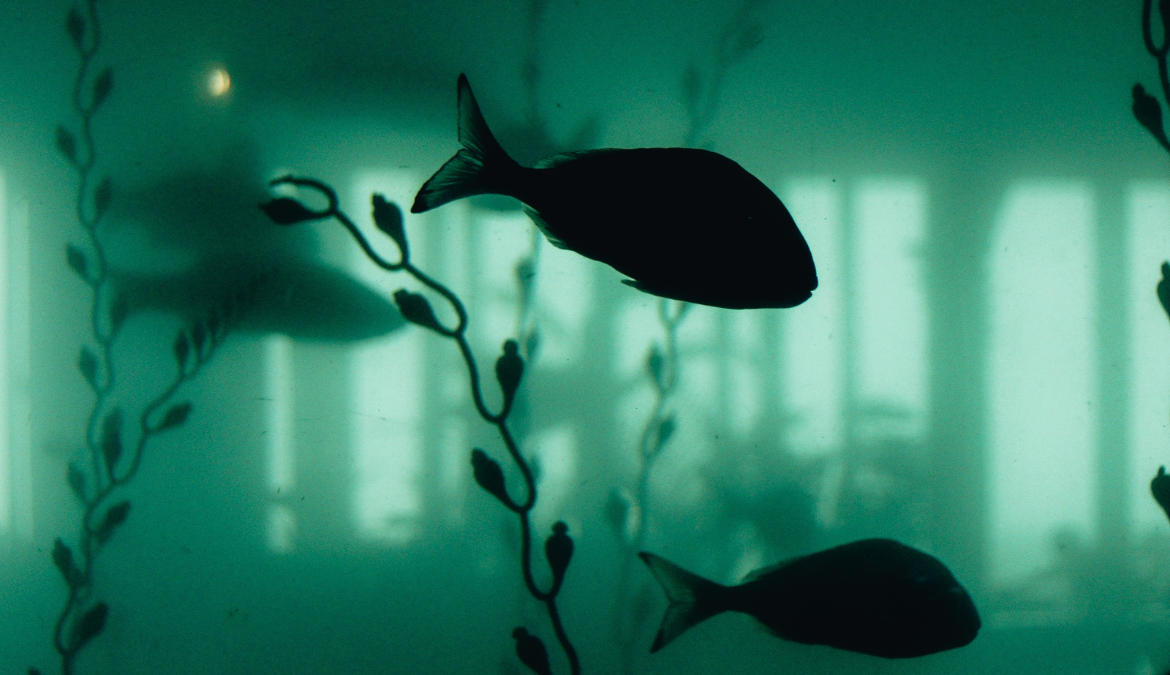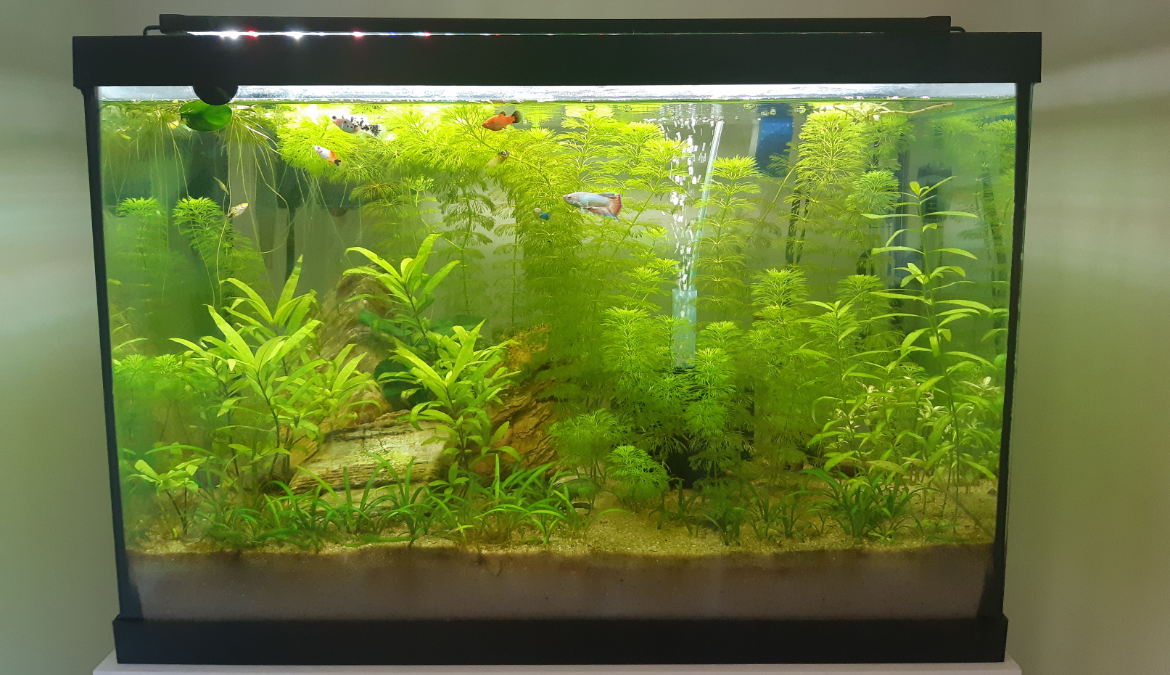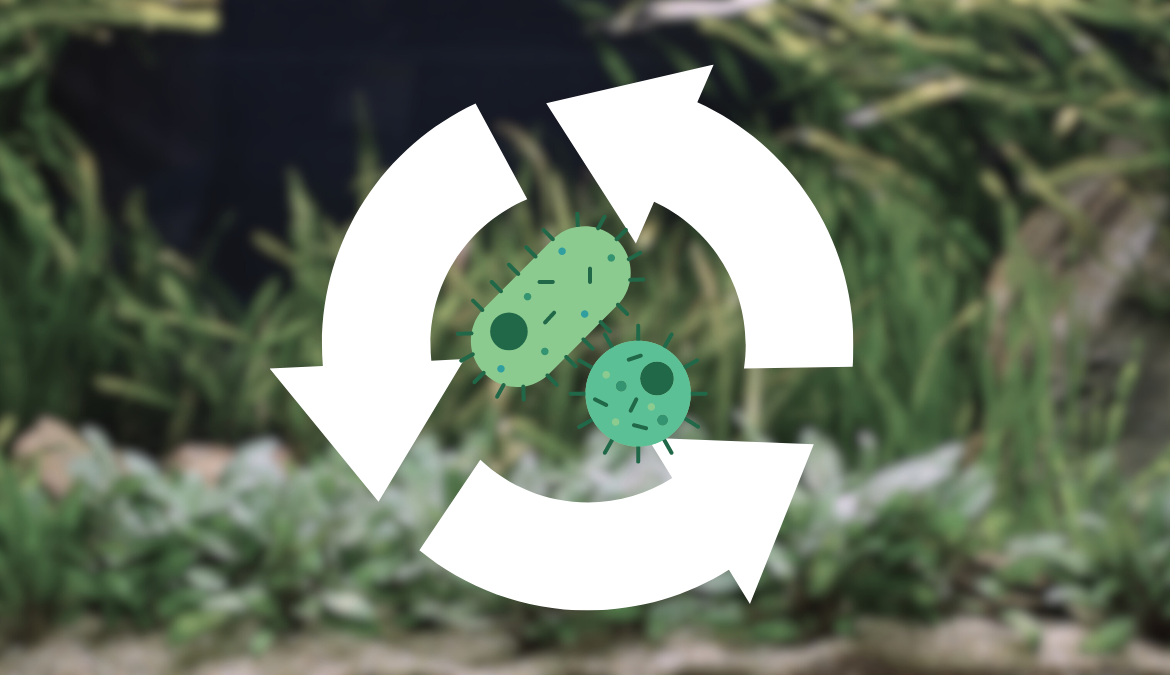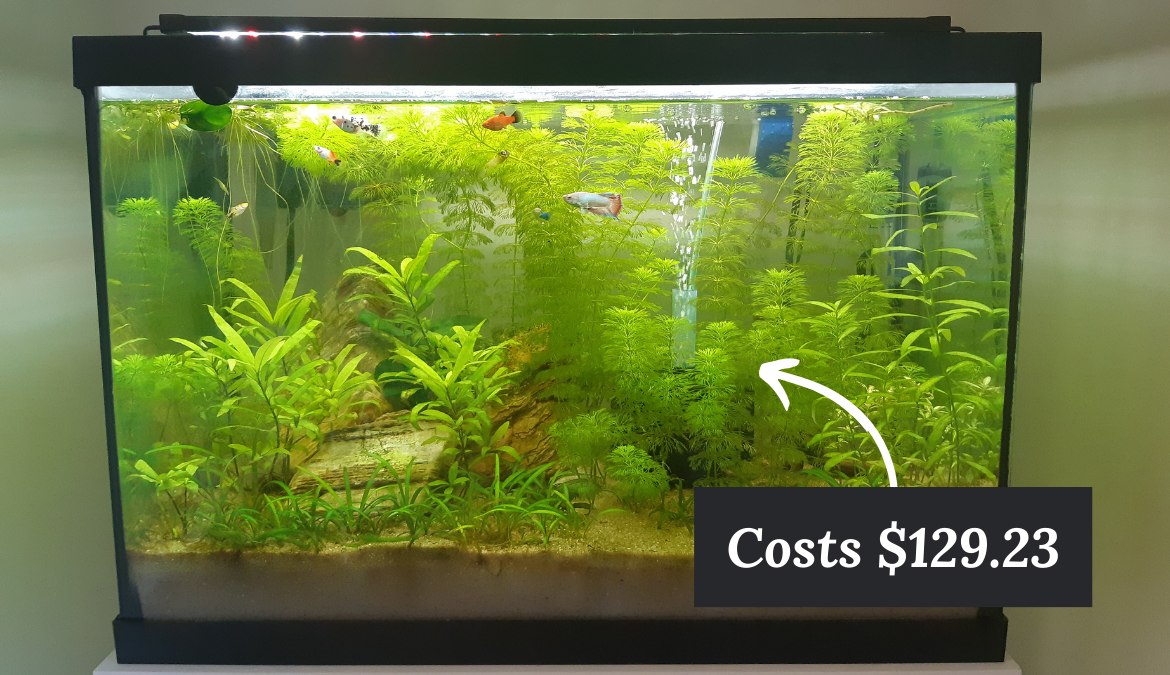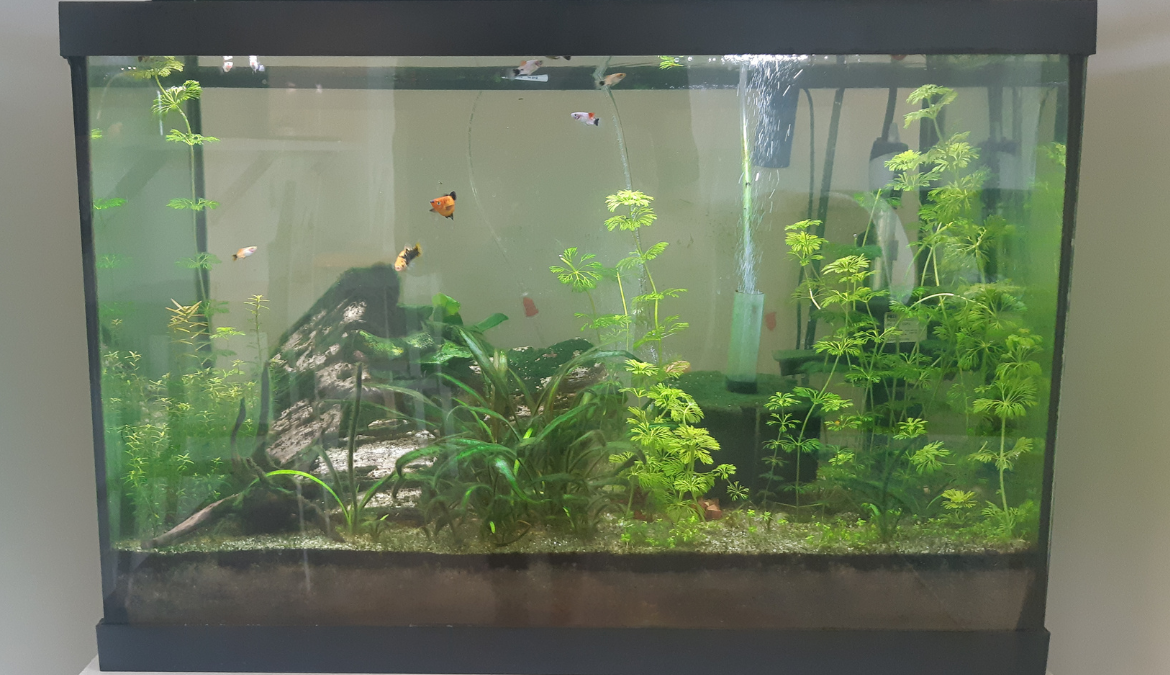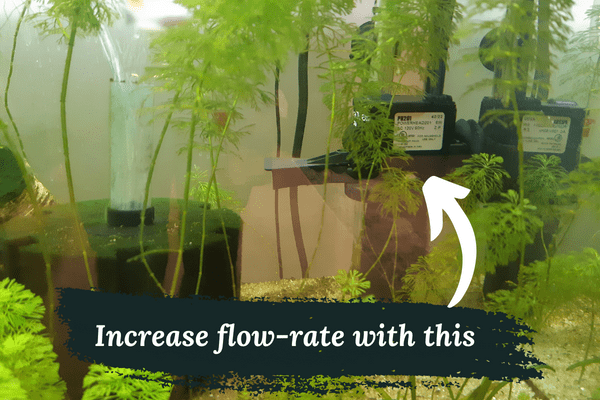Unusual fish behavior, discolored or dying plants, or excessive algae growth are potential physical symptoms of poor water quality in low-tech tanks. However, there are non-visible indicators such as high ammonia, nitrite, nitrate, or odor that can be measured by smell or via water quality test kits.
Poor water quality can lead to various problems, including stunted plant growth, fish stress, and diseases. It’s important to be aware of the signs indicating an issue with your tank’s water quality, as early detection and intervention can prevent significant issues.
As a low-tech planted tank owner, understanding the water quality is crucial for the overall success and longevity of your ecosystem. There are multiple factors to consider, such as physical indicators, fish behavior, and plant health.
Let’s dive in:

Key Takeaways
- Monitoring water quality in a low-tech planted tank is essential to maintain a healthy environment for plants and fish
- Physical indicators, fish behavior, and plant health can help detect poor water quality
- Regular testing and implementing preventive measures are crucial to improving and maintaining good water conditions.
Contents
- 1 Understanding Water Quality in a Low-Tech Planted Tank
- 2 Physical Indicators of Poor Water Quality
- 3 Fish Behavior Indicators of Poor Water Quality
- 4 Plant Health Indicators of Poor Water Quality
- 5 Health Problems in Fish Indicative of Poor Water Quality
- 6 Testing Water Quality
- 7 How to Improve Poor Water Quality
Understanding Water Quality in a Low-Tech Planted Tank
Explanation of Key Parameters
pH
The pH is a measure of the acidity or alkalinity of the water. For a low-tech planted tank, I’m able to achieve a slightly alkaline pH range of 7.5-8.5 due to my local water source in Calgary.
It’s possible to adjust your pH with additives or a reverse osmosis (RO) water treatment system. However, in the spirit of low-tech and low-maintenance tanks, I choose to build tanks around my default water conditions.
It’s useful to sample your tap water with a pH test strip or test solution droplet test:
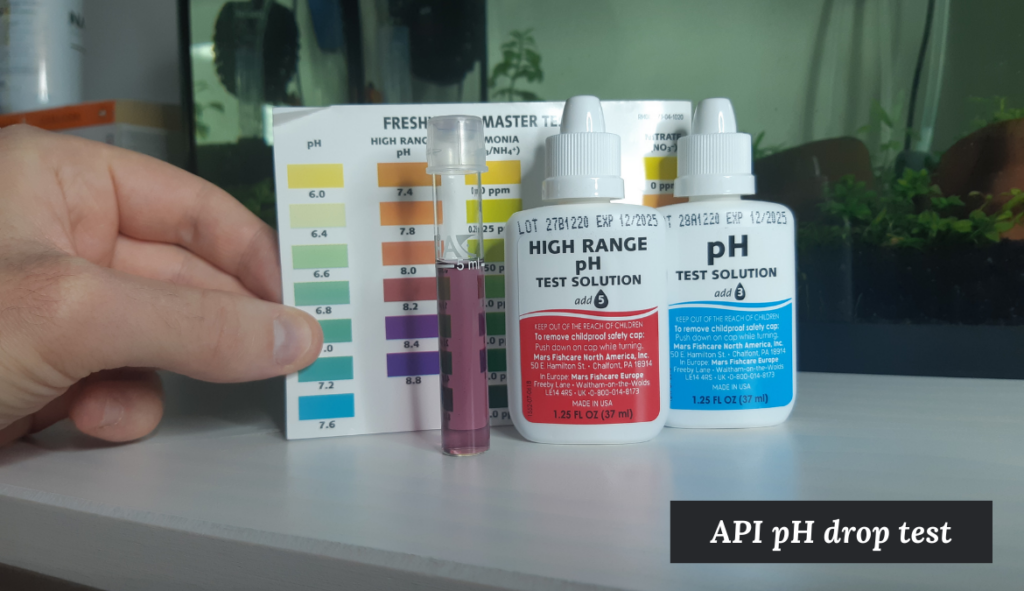
This limits me from keeping certain fish specie, such as Neon Tetras, or certain plant species that tend to thrive in lower pH environments.
With that being said, many plant and fish species will tolerate a range of water parameters. Just make sure to do a little research on your desired species beforehand.
The most important aspect of pH is ensuring it doesn’t fluctuate drastically. This is achieved by having moderate carbonate hardness (KH) levels, which protect your tank against pH changes.
You can measure you KH with an API water drop test:
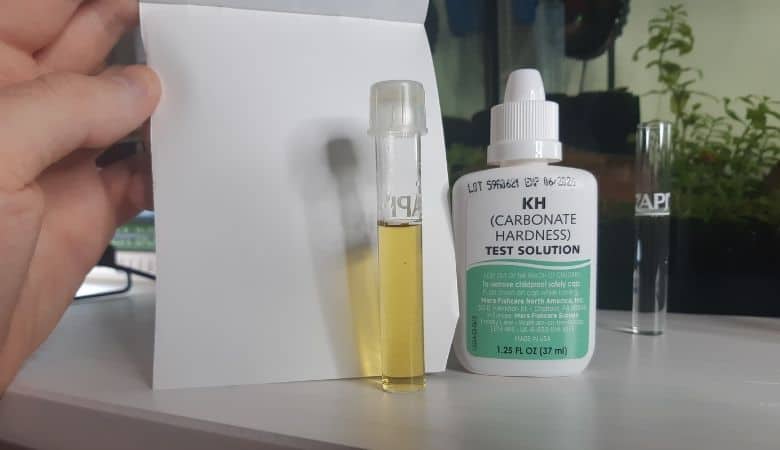
Ammonia
Ammonia is a toxic compound that can build up in an aquarium from waste, uneaten food, and decaying organic matter.
In my low-tech planted tank, I make sure the ammonia level remains at 0 ppm (parts per million), as even a small amount can be harmful to fish and plants. Regular water changes and proper tank maintenance are essential in preventing ammonia buildup.
Again, you can use an API Freshwater Test Kit to test for ammonia:
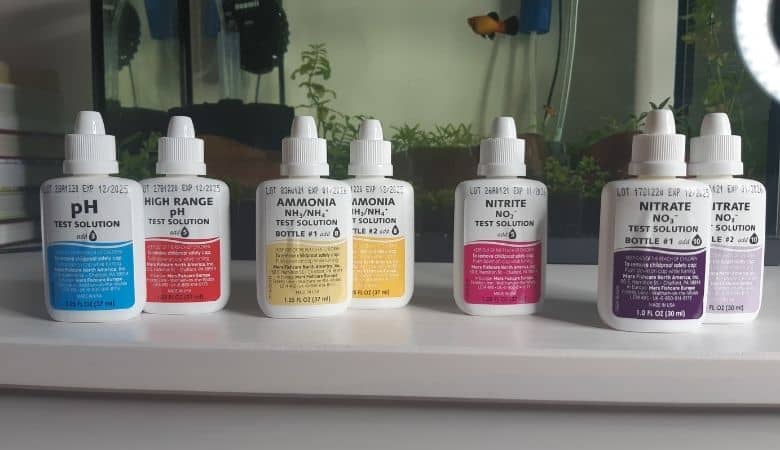
Over time your tank will grow colonies of Nitrosomonas, which is a strain of beneficial denitrifying bacteria that converts ammonia into nitrite.
Nitrite
Similar to ammonia, nitrite is a toxic compound produced during the nitrogen cycle in an aquarium. Nitrite levels should also be kept at 0 ppm to ensure a safe environment for aquatic life in my low-tech planted tank.
Another strain of beneficial bacteria called Nitrobacter break down nitrite into the less harmful nitrate.
Nitrate
Nitrate is the final byproduct of the nitrogen cycle. While not as toxic as ammonia or nitrite, high levels of nitrate can still have detrimental effects on fish and plants in a low-tech planted tank.
Ideal nitrate levels for a planted tank are below 40 ppm, although some people suggest that fish can tolerate concentrations much higher than this. Regular water changes and careful monitoring help keep nitrate levels under control.
If you have a deep substrate aquarium, you might be able to establish anaerobic bacteria that consume nitrate.
Hardness
Water hardness refers to the concentration of minerals, such as calcium and magnesium, in the water. In my low-tech planted tank, I aim for a balanced hardness level that supports the health of my plants and fish.
Different aquatic plants may have specific hardness requirements, so it’s essential to research the ideal levels for each species in your tank.
My tap water measures roughly 7 dKH and 14 dGH.
Physical Indicators of Poor Water Quality
Cloudy or Discolored Water
In a low-tech planted tank, I often notice that cloudy or discolored water can indicate poor water quality. This may be caused by an imbalance of nutrients, excess waste, or decaying plant matter.

It is essential to regularly monitor and maintain water parameters to ensure the health of my aquatic plants and prevent cloudy water. Regular water changes are important to maintain a healthy aquatic environment, as this helps remove excess nutrients and waste.
Presence of Algae Blooms
Algae blooms are another sign of poor water quality that I’ve encountered in my low-tech planted tank. Specifically, high concentrations of nutrients, such as nitrates and phosphates, can lead to the growth of algae.
In my experience, lighting plays a big role in algae development as well. Having your aquarium lights turned on for too long or too bright will promote algae growth.
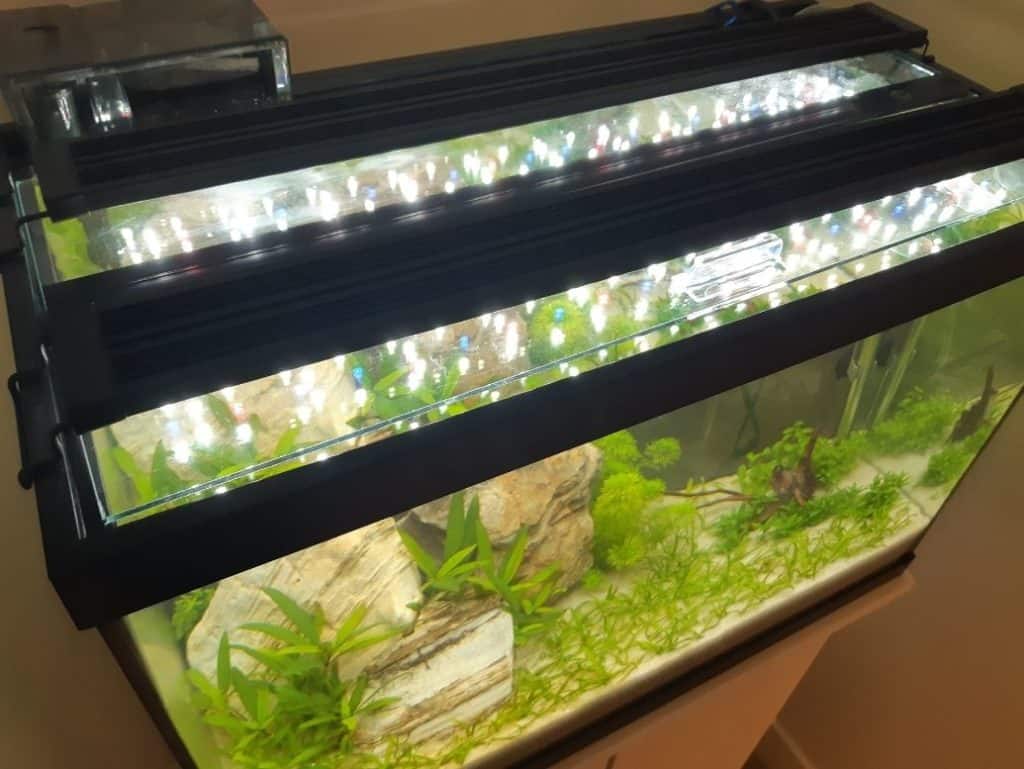
Having a balance of fast-growing plants in the tank may help to outcompete algae for nutrients. Additionally, maintaining proper lighting conditions can reduce the chances of algae growth.
I find it helpful to occasionally inspect for and remove any visible algae using a brush, sponge or scraper.
Bad Odor
A bad odor emanating from my low-tech planted tank may indicate poor water quality. Typically, this odor comes from decaying plant matter or excessive waste buildup from fish or invertebrates.
To address this issue, I make sure to frequently check and remove any dead or decaying plants and siphon out excess waste from the tank, ensuring it remains clean.
Debris and Unwanted Particles
I have found that debris and unwanted particles in my low-tech planted tank often serve as another sign of poor water quality. These particles may include uneaten food, decaying plant leaves, and fish waste.
Removing this debris helps prevent water quality issues, as well as prevent potential health problems for the tank’s inhabitants. I often use a fine mesh net, siphon, or filter floss to remove larger particles floating in the water.
By closely monitoring these physical indicators, I can maintain the well-being of my low-tech planted tank and ensure a healthy environment for my aquatic plants and animals.
Fish Behavior Indicators of Poor Water Quality
Decreased Activity or Lethargy
I’ve noticed that one of the first signs of poor water quality in a low-tech planted tank is a decrease in the activity of my fish.
It’s essential to monitor your fish and their behavior, as lethargy is a common response to deteriorating water conditions.
Fish may appear less active, stay at the bottom of the tank, or near the surface to gulp in more oxygen. This is especially noticeable in energetic species such as bettas or platies.
Unusual Aggression
Another sign of poor water quality in a low-tech planted tank is increased aggression among fish. When water quality is compromised, fish may experience increased stress levels, making them more likely to display unusual aggression towards tank mates.
It is particularly noticeable in fish species that are usually peaceful, like bettas. Keep an eye on interactions between fish and be prepared to address water quality issues if aggression increases.
There are other factors, such as overpopulation, that might cause aggression as well. So this is not a guaranteed sign. But it’s something to consider if you notice it.
Changes in Feeding Behavior
As I maintain my planted tank, I’ve noticed that poor water quality can also lead to changes in feeding behavior. Fish might eat less, refuse food, or have difficulty finding food due to stress or reduced energy levels caused by bad water conditions.
This can affect the health and well-being of fish in the tank, and it’s crucial to monitor their feeding habits. If I notice changes in the feeding behavior of my fish, I take it as a sign that it might be time to check the water quality parameters.
Unusual Swimming Patterns
Lastly, observing the swimming patterns of my fish often reveals information about the water quality in my planted tank. Unusual swimming patterns can indicate issues with water parameters, such as temperature, dissolved oxygen, or pH levels.
Fish may start swimming erratically or have difficulty navigating their environment if they are stressed by poor water quality.
Monitoring the behavior of your fish, including their swimming patterns, can provide insights into the health of your aquatic ecosystem.
Plant Health Indicators of Poor Water Quality
Yellowing or Browning of Plant Leaves
In my low-tech planted tank, one of the first signs of poor water quality is when I notice yellowing or browning of plant leaves. This can occur in various plant species, such as crypts, anubias, java fern, and echinodorus.
It is often due to deficiencies in essential nutrients and minerals or imbalances, which affect the overall health and growth of the plants. To address this, I usually check the water pH and alkalinity, and adjust as needed.
However, this is more frequently a result of plant nutrient deficiency rather than poor water quality. But plant health can be a symptom of water issues.
Algae Overgrowth on Plants
Another sign that I have observed in my low-tech planted tank is algae overgrowth on plants. Algae can grow rapidly when there are excess nutrients, strong lighting conditions, and poor water movement.
Plant species like java moss, moss balls, and vallisneria are especially prone to algae accumulation. Keeping the tank clean and maintaining proper nutrient levels will help me prevent excessive algae growth.
Slow or Stunted Plant Growth
In addition to leaf discoloration and algae overgrowth, poor water quality can result in slow or stunted plant growth. Live plants like crypt wendtii, carpet plants, and hornwort may not grow as expected, limiting their ability to provide shelter for aquatic life in the tank.
Improving factors such as water temperature, pH, and the presence of essential nutrients can greatly enhance plant growth and overall aquarium health. Regularly monitoring the water indicators allows me to keep the tank thriving.
Plant Death
The most severe sign of poor water quality in my low-tech planted tank is plant death. When plants like hygrophila polysperma and other species begin to die, it is a clear indication that something is seriously wrong with the water conditions.
At this point, I immediately perform a thorough analysis of the water quality, including factors such as pH, total dissolved solids, and nutrient levels. Identifying and rectifying these issues is crucial for maintaining the overall health and balance of my planted aquarium.
Health Problems in Fish Indicative of Poor Water Quality
Breathing Difficulties (Gasping at the Surface)
Gasping is often because of a lack of oxygen. In my opinion, the quickest and easiest way to increase oxygen concentration is by adding a sponge filter.
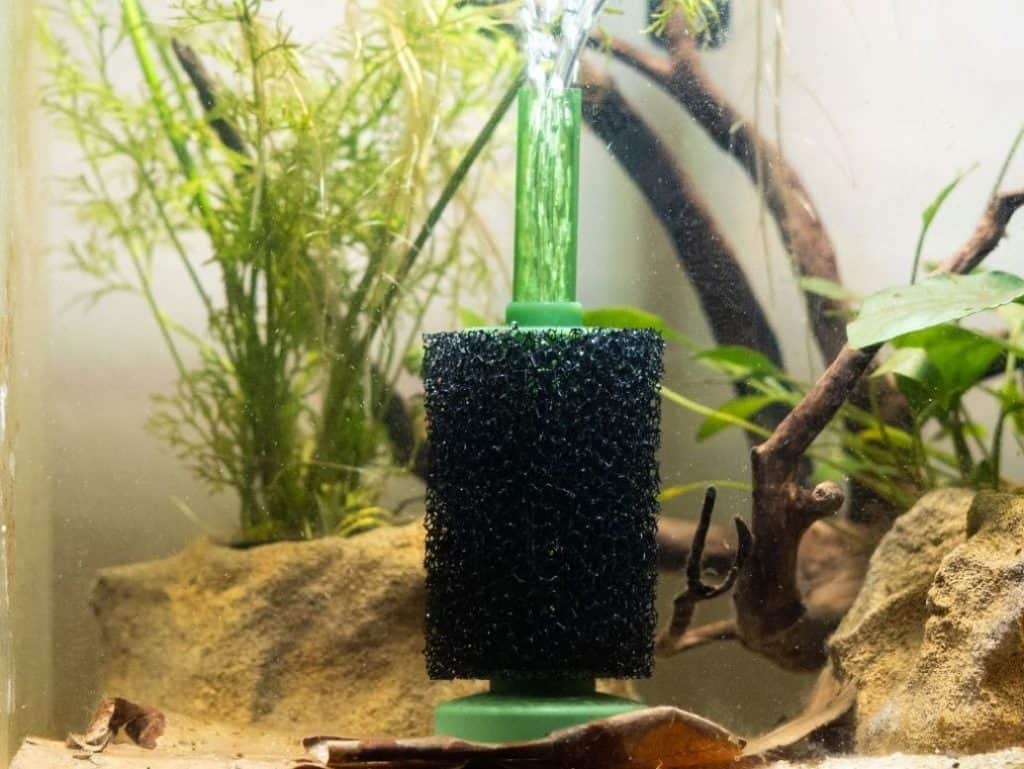
The bubbles pop at the water surface and create turbulence. This increases the surface area, causing gas exchange to occur more rapidly. This is what adds oxygen to the water column.
I also find sponge filters a reliable source of filtration for my tanks anyways so I highly recommend them.
Loss of Color or Brightness
Another visible sign of poor water quality in a planted aquarium is the loss of color or brightness in fish. A once vibrant and healthy goldfish may start to look dull and pale, which can be an indicator that the water conditions are not optimal. To prevent this, I ensure that the proper filtration system is in place and monitor water parameters closely.
Unexplained Deaths
Unexplained fish deaths are a serious red flag, pointing to poor water quality in the aquarium. A buildup of toxic substances may cause fish to die suddenly even if they seemed healthy just hours before.
Disease Outbreaks
Poor water quality can contribute to various diseases in fish. In fact, many fishkeepers simply treat the symptoms of a disease instead of addressing its root cause.
The thing is:
Parasites, bacteria and fungi are ineviatbly going to exist in your aquarium. The conditions are perfect for cultivating these types of organisms.
When your fish are healthy and happy, their immune systems are strong and capable of successfully warding off disease.
But when water quality deteriorates, it causes stress, lowering your fish’s immune system and making them more suceptible to disease. Therefore, poor water quality is often a root cause of a wide variety of fish illness and should be your primary focus for maintaining.
Testing Water Quality
Importance of Regular Testing
Testing water quality is essential for maintaining a healthy low-tech planted tank. By regularly testing the water parameters, I can detect any imbalances or potentially toxic substances quickly, and take action to correct them before they harm my plants and fish.
I use API’s Master Freshwater testing kit to test ammonia, nitrite, nitrate and pH in my tanks. I also separately buy API’s GH and KH test kits to measure my water’s general and carbonate hardness:
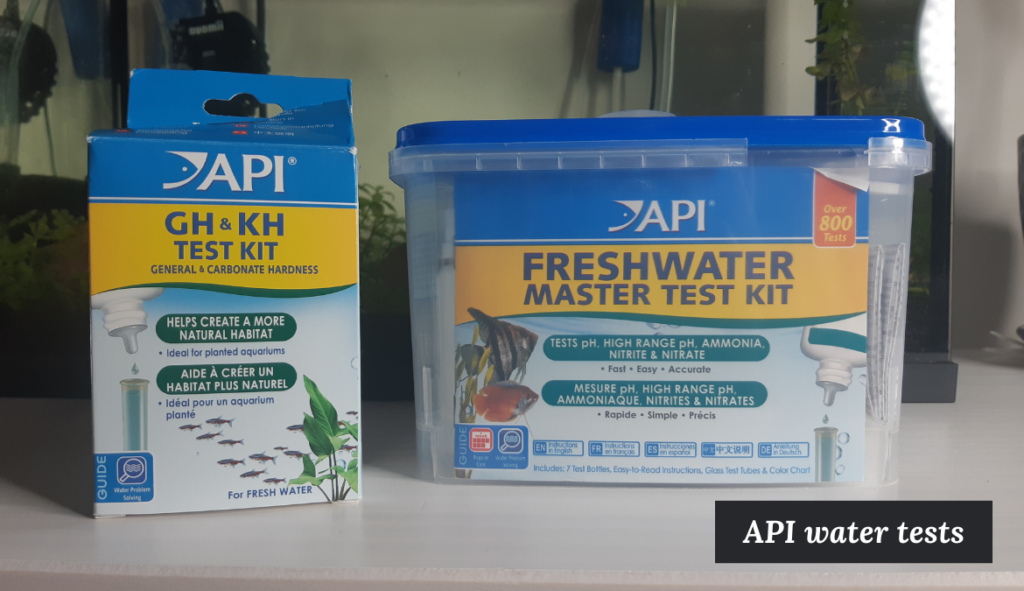
Regular testing allows me to monitor the nitrogen cycle in the aquarium, which involves the breakdown of ammonia (produced by fish waste and decomposing organic matter) into nitrite and then nitrate.
Over time, through the process of nitrification, nitrifying bacteria convert toxic ammonia and nitrites into less harmful nitrates.
How to Test Water Quality in a Low-Tech Planted Tank
I prefer using the API Freshwater Master Test Kit for testing water quality in my low-tech planted tank. This kit contains tests for ammonia, nitrite, nitrate, and pH, which are the most important parameters to monitor in an aquarium.
Understanding Test Results
Once I have my test results, I compare them with the recommended values for a low-tech planted tank. For example:
- Ammonia (NH3): Ideally, there should be no detectable ammonia in the tank. Levels above 0.25 ppm can be toxic to fish and plants.
- Nitrite (NO2): A healthy tank should have nitrite levels below 0.25 ppm. Higher levels indicate that there may be a problem with the nitrification process.
- Nitrate (NO3): Nitrates should ideally be below 40 ppm in a low-tech planted tank. Higher levels can cause algae growth, stress on fish, and health issues in some plant species. If necessary, I can use products like Seachem to remove excess nitrates.
Regular testing and understanding the test results help me maintain a healthy environment for my plants and fish, ensuring a thriving low-tech planted tank.
How to Improve Poor Water Quality
As a hobbyist maintaining a low-tech planted tank, I’ve faced my fair share of challenges, especially when it comes to water quality. Here, I’ll share some ways that have worked for me to improve the water quality in my tank.
Regular Water Changes and Tank Maintenance
A key aspect of maintaining a healthy aquarium is to conduct regular water changes. I usually perform water changes every week or two, replacing about 15-20% of the tank water each time.
This helps to reduce the buildup of ammonia, nitrates and phosphates.
Additionally, I ensure the filtration system is functional and clean the filter media regularly. It’s essential to remove debris and waste from the tank, as their decomposition can lead to poor water quality.
Adjusting Feeding Routines
Another important part of managing water quality in my low-tech planted tank is adjusting my feeding routines.
Overfeeding the fish can lead to increased waste and contribute to poor water quality. I monitor the amount of food provided, ensuring it fits both the number and species of fish. It’s better to err on the side of underfeeding than overfeeding when keeping the tank clean.
I choose to feed my platies one per day but could get away with feeding them every other day. And I only feed them the amount it takes for them to consume the food in less than 1 minute.
Consideration of Chemical Treatments
Using chemical treatments, such as water conditioners that remove chlorine and heavy metals, can help improve water quality. I usually add water conditioners during water changes to protect my fish and plants
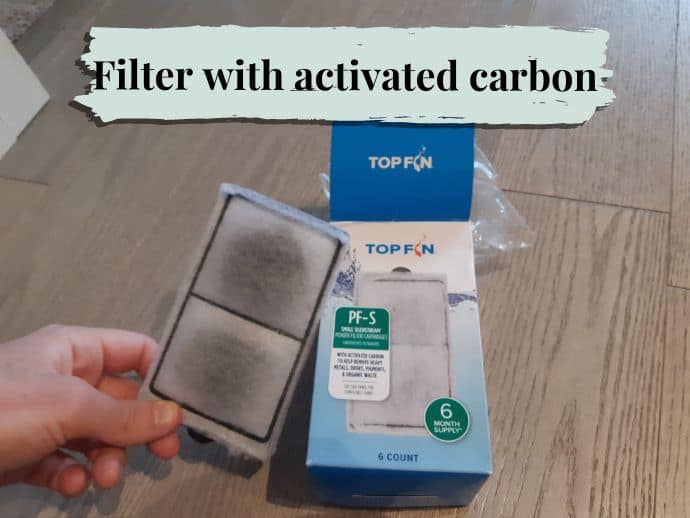
Activated carbon in the filter media can also be beneficial in removing harmful substances. However, it’s primarily used for removing medication after a tank-wide treatment.
Plant Health Management
I pay close attention to the health of my plants in the low-tech planted tank. If I notice any signs of rot or decay, such as wilted leaves or discolored stems, I trim them immediately.
This prevents the decay from releasing harmful substances into the water. Healthy plants are crucial for maintaining water quality, as they uptake nutrients and CO2, which in turn reduces algae growth and stabilizes water conditions.
Ensuring proper lighting is another significant aspect of plant health management. I keep my tank in a bright light environment, providing around 2 watts per gallon to support plant growth without encouraging an algae bloom.
Since my tank is a low-tech one, I opt for beginner-friendly plants such as crypts and limnophila sessiliflora, which are not as demanding.
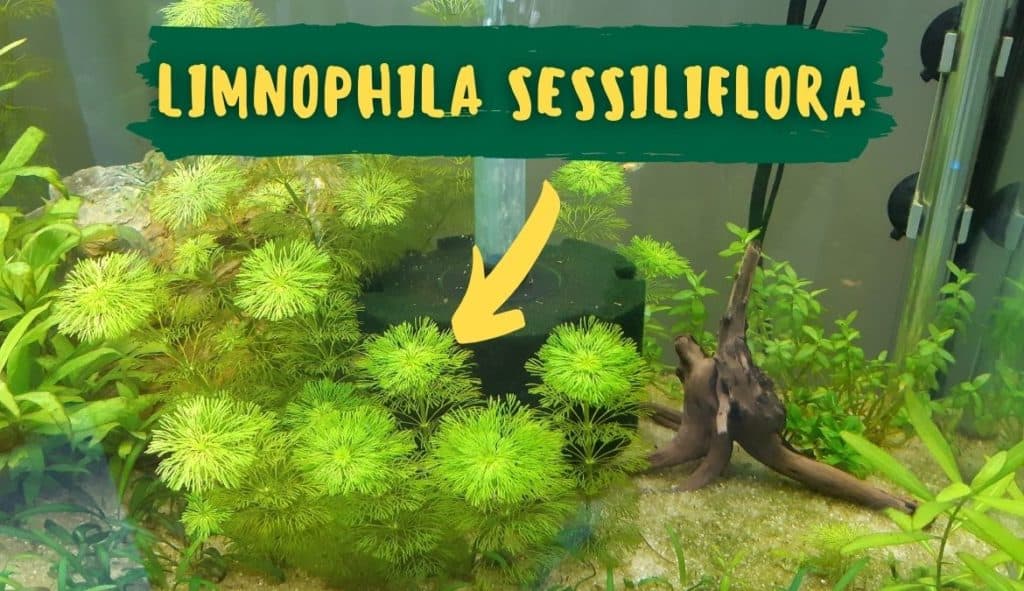
By implementing these strategies, I have been able to maintain and improve the water quality in my low-tech planted tank. Remember, consistency and patience are key when working towards a healthy aquarium.


